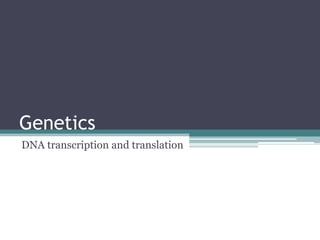
4.3 Transcription and Translation
- 1. Genetics DNA transcription and translation
- 2. Transcription • It is the synthesis of RNA using DNA as a template. • The base sequence of RNA id the same as one of the DNA, but uracil takes the place of thymine. • Types of RNA: • mRNA – messenger RNA • tRNA – transfer RNA • rRNA – ribosomal RNA • ―One gene – one polypeptide‖ concept: one polypeptide is synthesized using one type of mRNA that is obtained by transcribing one gene.
- 3. Remember DNA RNA Deoxyribonucleic acid Ribonucleic acid Deoxyribose sugar Ribose sugar C2 no oxygen C2 bonds to one OH group and one H Two polynucleotide chains One polynucleotide chain Bases are: ATGC Bases are: AUGC Uracil replaces Thymine Because RNA is single-stranded, transcription occurs along one strand only.
- 4. Formation of an RNA strand • The RNA that is produced has a sequence that is complimentary to the DNA that is used as a template for transcription. • The enzyme RNA polymerase binds to a site called the promoter (specific base sequences) • The region of DNA that is separated is the region of the gene to be transcribed. • Free nucleotides are in the nucleus space and they pair up with DNA bases following the sequence.
- 5. Formation of RNA • mRNA is a single polynucleotide chain but the base thymine is replaced by Uracil. • RNA polymerase forms covalent bonds between nucleotides (sugars and phosphates). • After the mRNA is complete, this "transcribed" message, detaches from the DNA and leaves the nucleus and directs the making of proteins in the cytoplasm, while the DNA remains in the nucleus. • The DNA helix reforms.
- 6. Translation • The base sequence of mRNA molecule is used as a guide for assembling the sequence of amino acids that will be a polypeptide a.k.a protein. • The process of protein production using mRNA is called translation. • Much as English can be translated into Russian, genetic translation converts nucleic acid language into amino acid language. • The flow of information from gene to protein is based on codons. A codon is a three-base "word" that codes for one amino acid. Several codons form a "sentence" that translates into a polypeptide.
- 7. example • Consider the following RNA sequence: • UCGCACGGU • This sequence would be read three bases at a time as: UCG-CAC-GGU • The codons represent the different amino acids: • UCG-CAC-GGU • Serine-Histidine-Glycine
- 8. The genetic code • The ―translation dictionary‖ is called the genetic code.
- 9. • Because there are 4 different bases, there are 64 possible three-base codons. • The codon AUG can either specify methionine or serve as the initiation ―start‖ codon. • There are 3 ―stop‖ codons that don’t code for any amino acid. • The genetic code is universal in that it operates the same way in nearly all living things on Earth.
- 10. Exercise your DNA • 1. A certain gene has the following sequence: • GACAAGTCCACAATC • 2. From left to right, write the mRNA sequence transcribed from this gene. • 3. Using the genetic code, read the mRNA codons from left to right, and write the amino acid sequence of the polypeptide translated from the mRNA. • 4. Repeat step 3 from right to left. • Why did steps 3 and 4 produce different polypeptides?
- 11. Translation • It takes place in the ribosomes: • An mRNA binds to the small subunit of the ribosome. • Following each codon, tRNA brings the proper amino acid into the ribosome • tRNA has 3 unpaired bases called anti-codon that are complimentary to one mRNA codon.
- 12. "P" site, holds the tRNA carrying the growing polypeptide chain. "A" site, holds a tRNA carrying the next amino acid to be added to the chain.
- 13. • The start codon AUG dictates where translation will begin. This lengthening process continues until the ribosome reaches a stop codon—UAA, UAG, or UGA. It releases the newly formed polypeptide and the mRNA molecule.
- 14. Introns and exons • Noncoding nucleotides: interrupt nucleotide sequences that actually code for amino acids. • Introns,inernalnoncoding regions • Exons, the coding regions that will be translated. • RNA splicing: intronsare removed and the exons are joined together
- 15. • Online activity 11.5
